Satelit Hubble Menangkap Foto Bayangan Galaksi
Posted in Uncategorized | September 18th, 2008
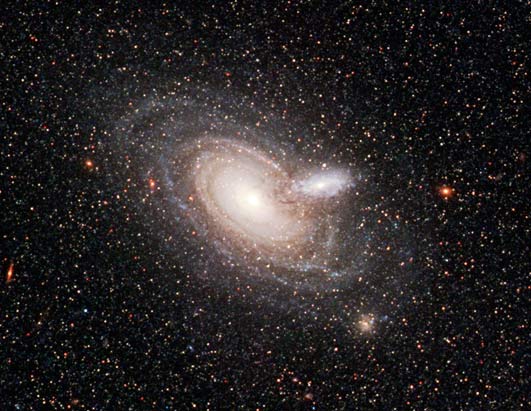
The Hubble telescope has captured a rare alignment between two spiral galaxies. The
outer rim of a small, foreground galaxy is silhouetted in front of a larger background galaxy. Skeletal tentacles of dust can be seen extending beyond the small galaxy’s disk of starlight. From ground-based telescopes, the two galaxies look like a single blob.
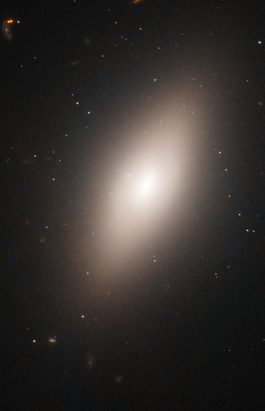
Globular star clusters, dense bunches of hundreds of thousands of stars, have some of the oldest surviving stars in the universe. A new study of globular clusters outside the Milky Way Galaxy has found evidence that these hardy pioneers are more likely to form in dense areas, where star birth occurs at a rapid rate, instead of uniformly from galaxy to galaxy. This is Virgo Cluster Galaxy NGC 4660. The Virgo Cluster is the nearest galaxy cluster to earth.
(E. Peng/ESA/NASA)
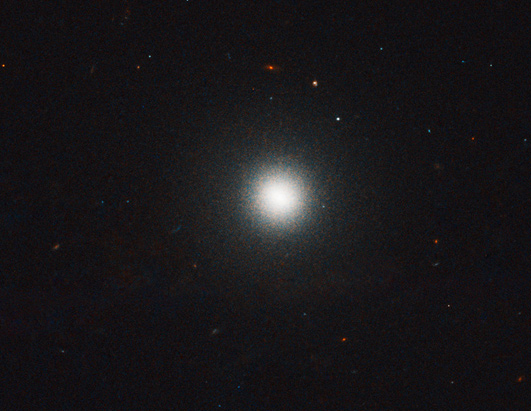
Because the Hubble telescope’s “eye” is so sharp, it was able to pick out the fuzzy globular clusters, like this oe — Virgo Cluster Galaxy VCC 1993 — from stars in our galaxy.
(E.Peng/ESA/NASA)
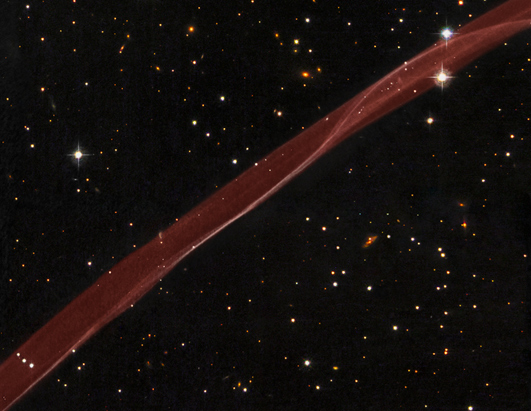
This “ribbon in the sky,” captured by the Hubble telescope, is actually a very thin section of a supernova remnant caused by a stellar explosion that occurred more than 1,000 years ago.
(NASA, ESA, and the Hubble Heritage Team)
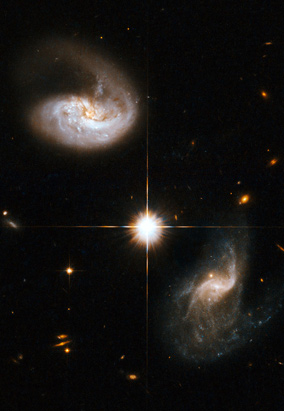
After 18 years in space, the Hubble telescope has caught more than a few breathtaking views, including several spiral galaxies. This galaxy, CGCG436-030, shows a very pronounced curling tail. The companion galaxy, located to the bottom-right of the image, displays an intricate structure, including a number of trails that extend quite far out from its core. The bright star that appears between the two galaxies does not belong to the either system and is part of the Milky Way.
(NASA, ESA, the Hubble Heritage Team (STScI/AURA)-ESA/Hubble Collaboration and A. Evans (University of Virginia, Charlottesville/NRAO/Stony Brook University))

These two interacting galaxies consist of NGC 5754, the large spiral on the top, and NGC 5752, the smaller companion in the bottom-left corner of the image.
(NASA, ESA, the Hubble Heritage Team (STScI/AURA)-ESA/Hubble Collaboration and W. Keel (University of Alabama, Tuscaloosa))
This galaxy pair lies in a crowded field of Milky Way stars and is located about 550 million light-years away from Earth.
(NASA, ESA, the Hubble Heritage Team (STScI/AURA)-ESA/Hubble Collaboration and A. Evans (University of Virginia, Charlottesville/NRAO/Stony Brook University))
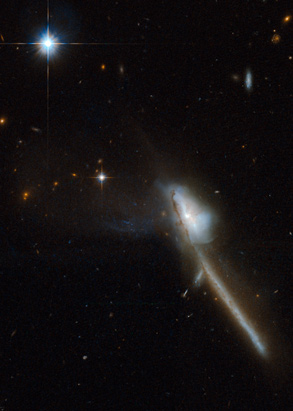
Markarian 273 is a galaxy with a structure that somewhat resembles a toothbrush. Its tail is about 130,000 light-years long and is may have been created by the merging of two galaxes.
(NASA, ESA, the Hubble Heritage Team (STScI/AURA)-ESA/Hubble Collaboration and A. Evans (University of Virginia, Charlottesville/NRAO/Stony Brook University)) 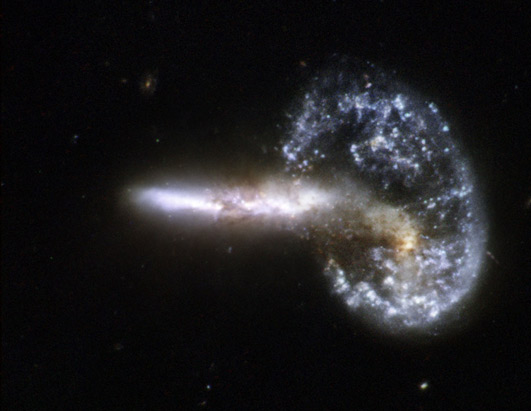

This galaxy, Arp 148, is a ring-shaped galaxy with a long tail, possibly the result of an ongoing collision between two galaxies.
(NASA, ESA, the Hubble Heritage Team (STScI/AURA)-ESA/Hubble Collaboration and A. Evans (University of Virginia, Charlottesville/NRAO/Stony Brook University), K. Noll (STScI), and J. Westphal (Caltech))

The latest image from the Hubble telescope reveals a sharp view of the spiral galaxy NGC 2397. This image also shows a rare Hubble view of the early stages of a supernova discovered in March 2006.
(NASA/ESA)

Probing a glowing bubble of gas and dust encircling a dying Sun-like star, NASA’s Hubble Space Telescope reveals a wealth of previously unseen structures in planetary nebula NGC 2371. The remnant star visible at the center of NGC 2371 is the super-hot core of the former red giant, now stripped of its outer layers. Its surface temperature is a scorching 240,000 degrees Fahrenheit. Prominent pink clouds of cool, dense gas lie on opposite sides of the central star. Also striking are the numerous, very small pink dots, marking relatively dense and small knots of gas, which also lie on diametrically opposite sides of the star. NGC 2371 lies about 4,300 light-years away in the constellation Gemini. The Hubble Wide Field Planetary Camera 2 images were taken in November 2007.
(NASA, ESA, and the Hubble Heritage Team (STScI/AURA))

The Hubble spotted a new galaxy. The elliptical galaxy NGC 1132 reveals the final result of what may have been a group of galaxies that merged together in the recent past. Another possibility is that the galaxy formed in isolation as a “lone wolf” in a universe ablaze with galaxy groups and clusters.
( Courtesy NASA, ESA, and the Hubble Heritage (STScI/AURA)-ESA/Hubble Collaboration)
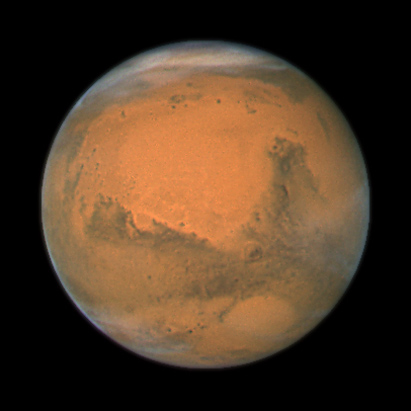
Mars made its closest approach to Earth on the evening of Dec. 18. Earth passes Mars and has such a “close encounter” about every 26 months. NASA’s Hubble Space Telescope took this close-up of the red planet when it was just 55 million miles away. This color image was assembled from a series of exposures taken within 36 hours of each other.
(NASA, ESA, the Hubble Heritage Team (STScI/AURA), J. Bell (Cornell University), and M. Wolff (Space Science Institute, Boulder))
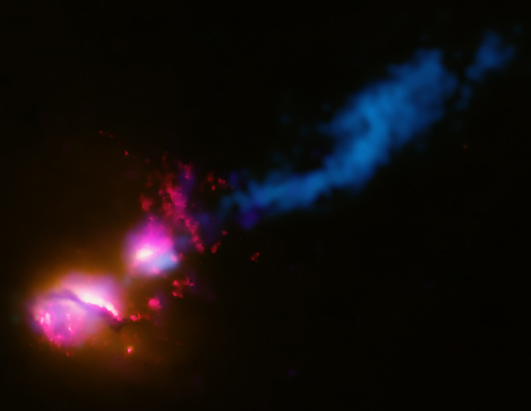
A powerful jet from a supermassive black hole is blasting a nearby galaxy, according to new results from NASA. This composite image shows the jet from a black hole at the center of a galaxy striking the edge of another galaxy, the first time such an interaction has been found. In the image, data from several wavelengths have been combined. X rays from Chandra (colored purple), optical and ultraviolet (UV) data from Hubble (red and orange), and radio emission from the Very Large Array (VLA) and MERLIN (blue) show how the jet from the main galaxy on the lower left is striking its companion galaxy to the upper right. The jet impacts the companion galaxy at its edge and is then disrupted and deflected, much like how a stream of water from a hose will splay out after hitting a wall at an angle.
(NASA/CXC/CfA/D.Evans et al.; Optical/UV: NASA/STScI; Radio: NSF/VLA/CfA/D.Evans et al., STFC/JBO/MERLIN)
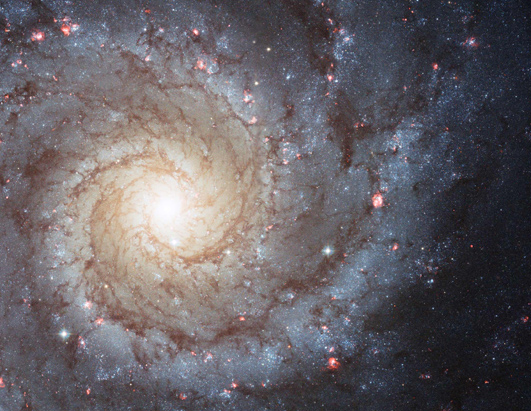
The newest Hubble image of spiral galaxy M74 resembles festive lights on a holiday wreath. Bright knots of glowing gas light up the spiral arms, indicating a rich environment of star formation.
(NASA)
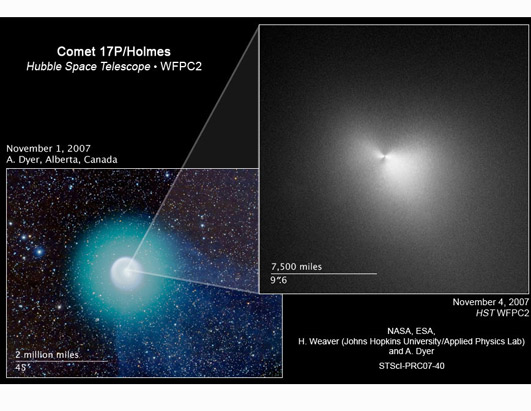
NASA’s Hubble Space Telescope has probed the bright core of Comet Holmes, which has mysteriously brightened by nearly a millionfold in a 24-hour period beginning Oct. 23, 2007.
(NASA)

Astronomers used Hubble’s powerful resolution to study Comet Holmes’ core for clues about how the comet brightened.
(NASA)

This image, taken by an amateur astronomer, shows the location of Comet Holmes on Oct. 28. Superimposed on this image is a graphic showing the comet’s path from Sept. 30 to Nov. 25.
(NASA)
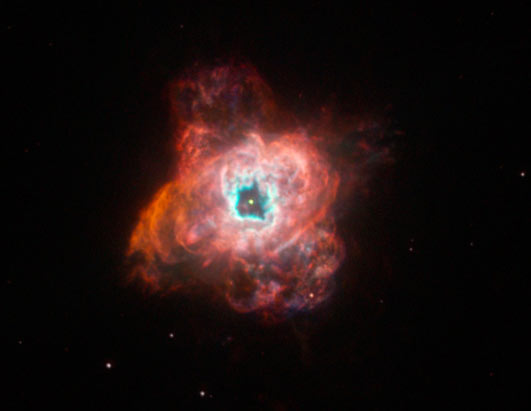
The colorful, intricate shapes in these NASA Hubble Space Telescope images reveal how the glowing gas ejected by dying sunlike stars evolves dramatically over time. These gaseous clouds, called planetary nebulae, are created when stars in the last stages of life cast off their outer layers of material into space. Ultraviolet light from the remnant star makes the material glow.
(NASA, ESA, and The Hubble Heritage Team)
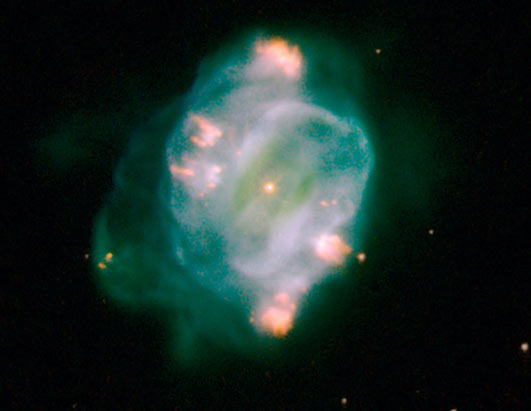
NGC 5307 displays a spiral pattern, which may have been caused by the dying star wobbling as it expelled jets of gas in different directions. NGC 5307 resides in the southern constellation Centaurus.
(NASA, ESA, and The Hubble Heritage Team)

In 2006, NASA’s Hubble Space Telescope captured the first ever picture of a group of five starlike images of a single distant quasar. The multiple-image effect seen in the Hubble picture is produced by a process called gravitational lensing, in which the gravitational field of a massive object — in this case, a cluster of galaxies — bends and amplifies light from an object — in this case, a quasar — farther behind it.
(K. Sharon (Tel Aviv University) and E. Ofek (Caltech)/ NASA/ ESA)
sumber:http://www.news-world.us/

Komentar
Posting Komentar